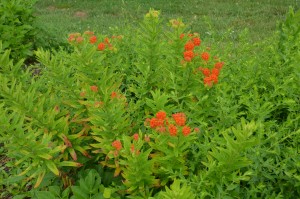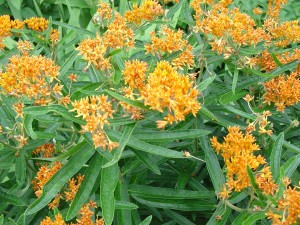Milkweed (Asclepias tuberosa), aka butterfly weeds, are tuberous rooted perennials native to the Eastern and southern U.S. (USDA hardiness zones 3 to 9). It grows in dry/rocky open woodlands, prairies, farm fields, and along roadsides. A clump of milkweed plants grow 1- 3 feet tall and spread 1 ½ feet wide. Unlike other milkweeds (Asclepias spp.), the sap is not milky.
For nearly six weeks, from late spring to early summer, 3 inch wide clusters of vibrant orange to yellow-orange flowers (umbels) cover the plant canopy. Narrow lance-shaped leaves are attached to the hairy stems. Flowers are an important nectar source for many butterfly species and leaves are a key food source for the caterpillars (larvae) of Monarch butterflies.
Butterfly weeds self-seed freely in the landscape. Prominent 3 – 6 inch long spindle-shaped seed pods break ripen, open and release multitudes of silky-tailed seeds which carry long distances by wind. Seed pods may be utilized in dried flower arrangements.
Butterfly weeds are prairie survivors. They grow in average well-drained soils in full sun. Two-year established plants are highly drought tolerant. Shoots emerge late in the spring and grow rapidly. Gardeners frequently include some in butterfly gardens, meadows, prairies, or other plantings. Do not attempt to dig up plants in the wild; they rarely survive transplanting due to their deep taproot system.
New plants are easily started from seed. Collect seed capsules from wild populations before they burst open. Dried capsules should be stored in a plastic bag. Autumn is a good time to direct sow seeds in a prepared garden bed. Most (not all) seeds will emerge by mid-summer next year, and plants will bloom for the first time in 2 – 3 years. Seeds may be sown into deep containers, but overall success is better in garden beds.
Few disease and insect problems trouble butterfly weeds when they’re grown in full sun open garden spot. Wet, poorly-drained soil leads to rot rots and eventual death. Leaves are susceptible to rust and leaf spots, particularly if the planting is too crowded or partially shaded.
‘Hello Yellow’ is a yellow-flowering milkweed cultivar. It possesses the same qualities of its orange-blooming cousin, including being a butterfly magnet.



 Posted in
Posted in 
